UNS A92124 is a heat-treatable aluminium alloy with excellent mechanical and physical properties. It is strong, lightweight, and corrosion-resistant, making it one of the most sought-after aluminium alloys in the market today. Whether you need an aerospace part or a car engine block, Aluminum 2124 can provide the perfect solution. In this blog post, we will explore the composition, chemical properties, mechanical properties, physical properties, uses, corrosion resistance, heat resistance, heat treatment, and machining of Aluminium 2124.
Aluminum 2124 Composition
Aluminum 2124 comprises 99.8% aluminum along with 0.25% copper, 1% manganese, and 0.2% chromium as its principal elements. This combination gives it high strength and great fabrication characteristics, making it ideal for various applications, from aircraft parts to automotive components.
| Element | Content (%) |
|---|---|
| Aluminium / Aluminum, Al | 93.50 |
| Copper, Cu | 4.4 |
| Magnesium, Mg | 1.5 |
| Manganese, Mn | 0.6 |
Aluminium 2124 Chemical Properties
The chemical properties of Aluminum 2124 are largely due to the presence of copper in its composition, which enhances its corrosion resistance by forming protective oxide layers on its surface when exposed to air or water. It also has great formability and weldability, making it a great choice for many applications, such as aerospace components, where accuracy and strength are essential.
Aluminium 2124 Thermal Properties
| Properties | Conditions | ||
|---|---|---|---|
| T (ºC) | Treatment | ||
| Thermal conductivity | 191 (W/mK) | 25 | O |
Aluminium 2124 Mechanical Properties
The mechanical properties of UNS A92124 include high tensile strength (around 270MPa), which makes it ideal for applications where strength is required, such as structural components or aircraft parts that need to withstand extreme forces during flight operations. Its yield strength is around 200 MPa, while its elongation at the breaking point is around 14%. Its modulus of elasticity is 70 GPa which provides good rigidity in static loading situations like bridges or building structures while still allowing flexibility under dynamic loading conditions like cars or airplanes in motion.
| Properties | Metric | Imperial |
|---|---|---|
| Elastic modulus | 70-80 GPa | 10152-11603 ksi |
| Poisson’s ratio | 0.33 | 0.33 |
Aluminium 2124 Physical Properties
The physical properties of UNS A92124 include good electrical conductivity (about 40 % IACS), making it suitable for applications where electricity needs to be conducted through metallic components like electric motors or electronic circuit boards; low thermal expansion coefficient (about 12 x 10^(-6) /K); low density (about 2700 kg/m³); and good workability both in hot and cold working conditions allowing for easy shaping into complex shapes using conventional tools like lathes or milling machines.
| Properties | Metric | Imperial |
|---|---|---|
| Density | 2.6-2.8 g/cm3 | 0.0939-0.1011 lb/in3 |
| Melting point | 510°C | 950°F |
Aluminium 2124 Uses
Aluminum 2124 is an alloy made of copper, magnesium, manganese and chromium, which suits it for various uses. Common applications include defence components, aerospace components, marine vessels, heavy vehicles and sporting equipment. Aluminium 2124 also has excellent machinability and weldability, which is why it’s one of the most used aluminium alloys in the manufacturing industry. On top of that, its effective corrosion resistance makes it a great choice for eco-friendly applications like solar panel frames and wind turbines. Overall, the versatility of aluminium 2124 makes it one of the most popular aluminium alloys in industrial practices today.
Aluminium 2124 Equivalent
- AMS 4221
- ASTM B209
- QQ A-250/29
- QQ A250/9
Heat Resistance
The heat resistance & heat treatment characteristics of Aluminum 2129 are excellent due to its high melting point (at about 640°C), allowing for use in temperatures up to 350°C without significant deformation over time.
Heat Treatment
Strengthening can be achieved by subjecting it to various heat treatments such as annealing or quenching & ageing processes which can increase its yield strength up to 300MPa while not significantly reducing ductility values below 10%.
Machining
Machining aluminium alloys can be challenging, but with proper knowledge and understanding, they can be easily worked with conventional tools such as lathes & milling machines; however, some extra care must be taken since aluminium alloys tend to work harden quickly, so frequent annealing must be done when machining complex shapes with tight tolerances if necessary – otherwise cutting tool life can quickly diminish resulting in costly delays due to premature tool wear & tear.
Welding
Welding aluminium alloys can also be tricky, but with proper technique, they can also be easily joined together without any significant issues; however, care must be taken not only during welding but also before welding since contaminated surfaces will weaken joints significantly, thus increasing chances for failure during operation – therefore proper preparation steps such as cleaning & degreasing must always be done prior welding if optimal results are desired.
Conclusion
Aluminum2123 is a great choice for many applications due to its excellent mechanical & physical properties combined with good workability & weldability; however, some extra care must always be taken when machining & welding this alloy if optimal results are desired. With proper knowledge, understanding, technique, patience, preparation & practice, anyone should have no problem working with this material.

Abhishek is a seasoned blogger and industry expert, sharing his insights and knowledge on various topics. With his research, Abhishek offers valuable insights and tips for professionals and enthusiasts. Follow him for expert advice on the latest trends and developments in the metal industry.




